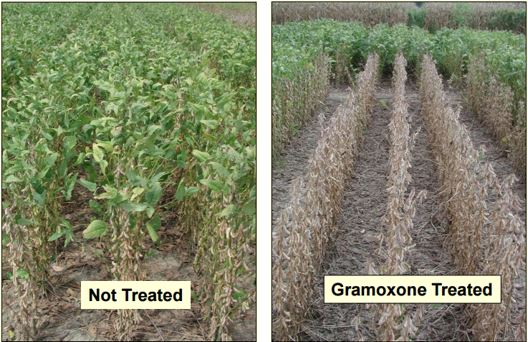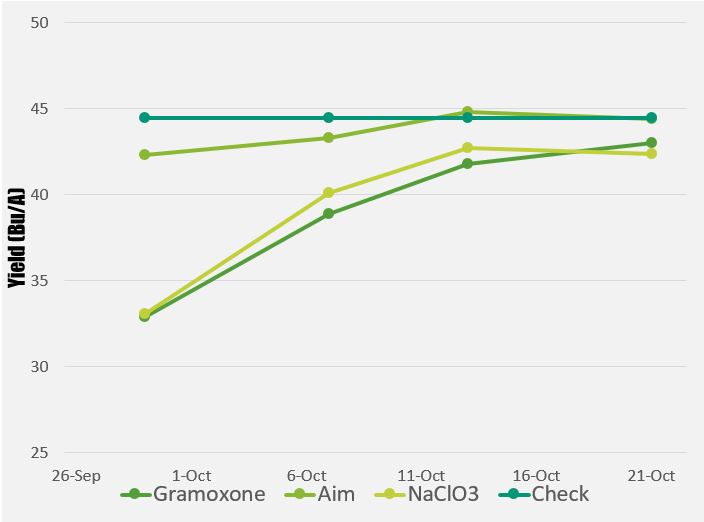As the end of the growing season nears, many growers are anxious to get their soybeans out of the field and into a bin where they are safe from the elements (especially after Matthew last year). Once soybeans are physiologically mature, nothing good is going to happen to them in the field. In addition, there may be a price premium for being one of the first soybean producers to the elevator with beans for sale. One way to harvest sooner may be to use desiccants to kill green tissue of beans or weeds so the combine can get through the field earlier.

Image from Griffin et al. (2013).
To help answer this question, Drs. Jim Dunphy and Wes Everman evaluated three different harvest aids in a project funded by the North Carolina Soybean Producers Association. The three products included Gramoxone (paraquat), Aim, and sodium chlorate. The average yield of each treatment after two years of data is presented in the graph below. The date is the average date when the treatments were applied across all environments. The first application (average date of September 28) was made at the approximately R6 stage (full sized seed in the pod).

There are a couple take home messages from this graph.
- Gramoxone and sodium chlorate are both effective at killing soybeans but regardless of when they were applied, both lead to reductions in yield. This is likely because at R6 the beans still haven’t reached physiological maturity yet (this doesn’t occur until R7) and by killing the plant at R6 you are stopping it from adding additional dry matter to the beans. It’s likely by the time of the last application (mid to late October) the plants were reaching physiological maturity and thus the difference in yield between the treated and non-treated beans was not very different.
A group of agronomists at LSU has done a lot of work evaluating harvest aids and their recommendation is to apply harvest aids at physiological maturity to prevent yield loss. To determine when a field is at physiological maturity they suggest collecting pods from the top third of plants and opening the pods to look for separation of beans from the white membrane inside the pod. If all pods collected have beans that are separated from the membrane, the beans are at physiological maturity and have reached their maximum dry weight.
Since Gramoxone and sodium chlorate are both effective at killing the beans, sodium chlorate may be attractive if you are trying to get in the field sooner. The sodium chlorate label states that application should be made 7 to 10 days before anticipated harvest while the Gramoxone lable states to not apply within 15 days of harvest.
- Aim is not effective at killing the soybeans compared to Gramoxone and sodium chlorate. Although there was little yield loss in Aim compared to the untreated check, Aim did not do a good job of killing the beans and thus is likely not an effective harvest aid. Aim may be a better choice if your only goal is to kill weeds (especially vines) before harvest.
The decision to use harvest aids should be made on a farm by farm basis and you should weigh the gain in time from being able to harvest earlier versus the loss in yield if plants are killed before they reach physiological maturity when making a decision.
References:
Griffin, J.L., C.A. Jones, L.M. Etheredge, Jr., J. Boudreaux, and D.Y. Lanclos. 2013. Harvest Aids in Soybeans – Application Timing and Value. LSU Research & Extension. http://mssoy.org/uploads/2013/09/HARVEST-AIDS-LSU-PP-2.pdf.
Levy, R. and J.L. Griffin. 2012. Soybeans Harvest Aid Recommendations for 2012. LSU Research & Extension. http://deltafarmpress.com/soybeans/soybeans-harvest-aid-recommendations-2012.






